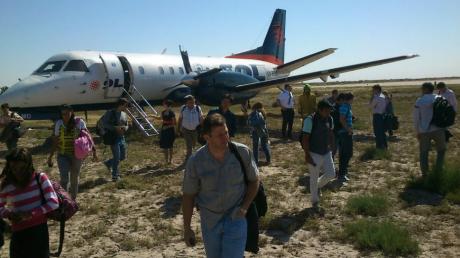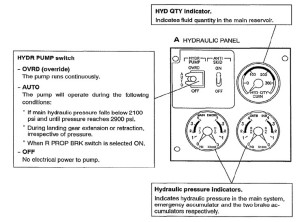Procedural Drift at Saab 340 Operator Leads to Taxiway Excursion
Saab 340A LV-BMD, operated by SOL Líneas Aéreas was damaged beyond economic repair in a taxiway excursion accident at Mendoza-El Plumerillo Airport, Argentina on 2 January 2013. There were no injuries among the 31 passengers and crew.
Argentina’s air accident investigation agency, the Junta de Investigación de Accidentes de Aviación Civil (JIAAC), issued their final report (in Spanish only) on 23 December 2015.
The crew initially attempted to start the right-hand engine. This failed, but they were able to start the left-hand engine and then successfully start the right-hand engine after that.
Upon taxying, the Captain encountered difficulties in maintaining directional control of the aircraft and in particular when trying to turn right found the aircraft was in fact turning left. The checklist was not consulted. Asymmetric braking and asymmetric engine power were both attempted but proved ineffectual. The aircraft left the paved surface of the taxiway and came to a halt 58 meters from the edge of the taxiway with both propellers contacting obstacles.
The Saab 340 uses hydraulic power for landing gear retraction, braking, nose wheel steering and flaps. The investigation identified that the electric pump that powered the hydraulic system was not operating. Consequently, the HYD warning on the central panel warning (CWP) was illuminated (although it does not appear to have been noticed)
The pump is controlled using a panel with three settings: OVRD / AUTO / OFF
The switch would normally be in the AUTO position (and the loss of directional control checklist, if followed, would have first checked this switch was in AUTO).
However, during post-accident interviews it emerged that an undocumented, but orally communicated and unnecessary practice had developed within the operator of setting the switch to OFF during engine starts. This was allegedly done with the intention of protecting the electronic system flight instrument system (EFIS) from electrical spikes.
While the JIAAC don’t comment, its possible that the initial right-hand engine failure to start may have distracted the crew from reselecting AUTO.
Procedural Drift / Practical Drift
The accident investigators comment of the phenomena of procedural drift / practical drift.
This is something we discussed in our article: ‘Procedural Drift’: Lynx CFIT in Afghanistan
One major study of an accident that featured drift was by Scott Snook, then of the US Army. His book, Friendly Fire, examined the accident shoot down of two US Army Black Hawk helicopters on a peacekeeping mission in Iraq in 1994 by the US Air Force, and what he called ‘practical drift’.
Such drift occurs when group norms and practices start to deviate from formal procedures. In some cases this may be because procedures no longer match operational circumstances, however practicality can be a factor too. These do not appear to have been factors here. Instead the practice seems simply to have been a misguided ‘improvement’.
In The Field Guide to Understanding Human Error Prof Sidney Dekker lists several potential reasons for procedural drift:
- Rules or procedures are over-designed and do not match up with the way work is really done.
- There are conflicting priorities which make it confusing about which procedure is most important.
- Past success (in deviating from the norm) is taken as a guarantee for safety. It becomes self-reinforcing.
- Departures from the routine become routine. Violations become compliant behaviour with local norms.
Safety Management System
The JIACC note that the operator’s Safety Management System (SMS) did not detect this drift.
The JIACC question the effectiveness of the SMS but provide no further evidence on the functioning of the SMS so it’s not possible for us to discuss this aspect further.
Checklists
Not for the first time the failure to follow the appropriate checklists has contributed to an accident:
- Gulfstream G-IV Take Off Accident & Human Factors
- Fatal G-IV Runway Excursion Accident in France – Lessons
- Metro III: Propulsion System Malfunction + Inappropriate Crew Response
- B1900C PSM+ICR Accident in Pakistan
- ANSV Highlight Procedures & HF After ATR72 Landing Accident
- UPDATE 8 July 2018: Distracted B1900C Wheels Up Landing in the Bahamas
- UPDATE 13 January 2019: Human Factors of the Selection of Parking Brake Instead of Speed Brake During a Hectic Approach (ERJ145 at Runway Excursion at Bristol)
- UPDATE 6 January 2020: Runway Excursion Exposes Safety Management Issues
- UPDATE 4 October 2020: Investigators Suggest Cultural Indifference to Checklist Use a Factor in TAROM ATR42 Runway Excursion
- UPDATE 4 April 2021: Fatal 2019 DC-3 Turbo Prop Accident, Positioning for FAA Flight Test: Power Loss Plus Failure to Feather
The JIACC do not examine training or wider flight operations standards, so it’s not possible to discuss those aspects further ere.
Safety Recommendations
Thirteen recommendations are raised in the report,
Aerossurance has extensive air safety, operations, airworthiness, maintenance human factors, aviation regulation and safety analysis experience. For practical aviation advice you can trust, contact us at: enquiries@aerossurance.com
Follow us on LinkedIn and on Twitter @Aerossurance for our latest updates.



Recent Comments